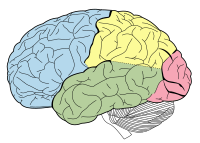
Photo from wikipedia
OBJECTIVE Brain-computer interface (BCI) technology enables people to use direct measures of brain activity for communication and control. The National Center for Adaptive Neurotechnologies (NCAN) and Helen Hayes Hospital are… Click to show full abstract
OBJECTIVE Brain-computer interface (BCI) technology enables people to use direct measures of brain activity for communication and control. The National Center for Adaptive Neurotechnologies (NCAN) and Helen Hayes Hospital are studying long-term independent home use of P300-based BCIs by people with amyotrophic lateral sclerosis (ALS). This BCI use takes place without technical oversight, and users can encounter substantial variation in their day-to-day BCI performance. The purpose of this study is to identify and evaluate features in the electroencephalogram (EEG) that correlate with successful BCI performance during home use with the goal of improving BCI for people with neuromuscular disorders. APPROACH Nine people with ALS used a P300-based BCI at home over several months for communication and computer control. Sessions from a routine calibration task were categorized as successful (≥70%) or unsuccessful (<70%) BCI performance. The correlation of temporal and spectral EEG features with BCI performance was then evaluated. MAIN RESULTS BCI performance was positively correlated with an increase in alpha-band (8-14 Hz) activity at locations PO8, P3, Pz, and P4; and beta-band (15-30 Hz) activity at occipital locations. In addition, performance was significantly positively correlated with a positive deflection in EEG amplitude around 220 ms at frontal mid-line locations (i.e., Fz and Cz). BCI performance was negatively correlated with delta-band (1-3 Hz) activity recorded from occipital locations. SIGNIFICANCE These results highlight the variability found in the EEG and describe EEG features that correlate with successful BCI performance during day-to-day use of a P300-based BCI by people with ALS. These results should inform studies focused on improved BCI reliability for people with neuromuscular disorders.
Journal Title: Journal of neural engineering
Year Published: 2019
Link to full text (if available)
Share on Social Media: Sign Up to like & get
recommendations!